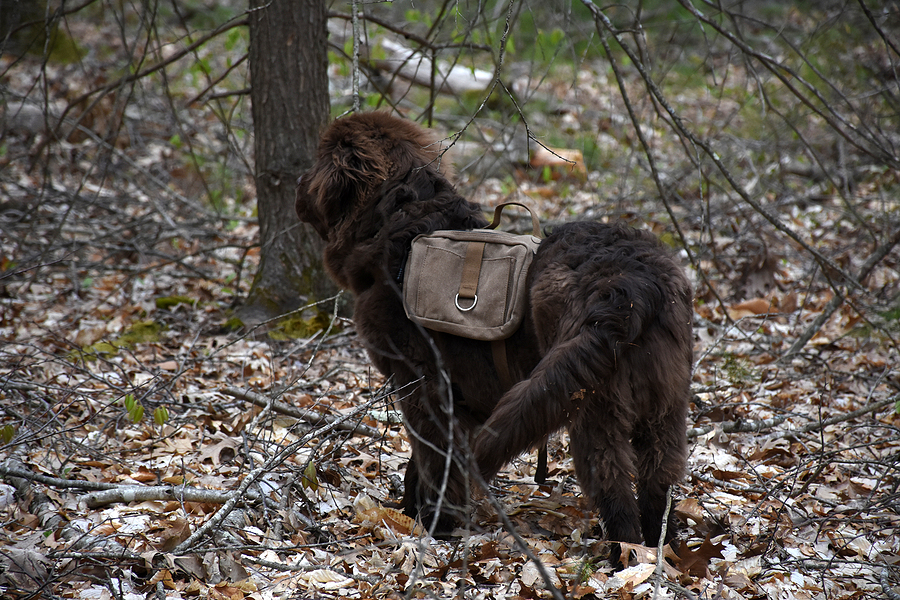Hiking is one of the most special ways to spend time outdoors with dogs. Besides the activity aspect, they open our eyes to the presence of birds and wildlife—I still remember fondly the time my dog Bella “pointed” mule deer—and remind us to stop and smell the flowers, listen to the bees and woodpeckers, and take in beautiful vistas. And no matter where we live, most of us are within a half hour of hiking trails that welcome dogs. (If you don’t, check www.sniffspot.com for nearby private hiking spots that welcome dogs.) The following tips will help you and your dog make the most of the great outdoors.
- Condition dogs gradually, whether they are puppies, seniors, or in their prime. If you want to be a weekend warrior, that’s on you, but your dog doesn’t have a choice. Start short and slow — a half-mile to a mile — and gradually increase your pace and distance. Talk to your veterinarian first, especially if your dog is young, a senior, has a short face, or has any health conditions.
- Tote plenty of water. Each person and dog should have at least a quart of water to sip from. Remaining hydrated is an important part of hiking safety and heatstroke prevention. Offer water frequently and bring extra if you’re tackling tough terrain.
- Pack snacks. To keep up his energy on the trail, your dog will appreciate handouts of boiled chicken chunks, cut-up hot dogs, or cubes of cheese. Freeze the snack bites the night before to help them stay fresh.
- Check the weather. Dogs don’t sweat the way humans do, so they are extra-sensitive to heat and humidity. Plenty of dogs wilt quickly, even in seemingly cool temperatures below 70 degrees Fahrenheit. Even if it doesn’t seem hot to you, dogs are lower to the ground and may not have the benefit of a breeze. Flat-faced dogs, who already have difficulty breathing, are at even greater risk. Any time the temperature exceeds 80 degrees Fahrenheit, it’s best to leave your dog at home unless she is conditioned to working at that temperature (and hiking is work).
- Stay cool. For a short hike near home, consider hosing down your dog before you leave to help him stay cool, or stop during the hike at a place where he can go swimming or get wet. Other ways to help him beat the heat include cooling coats and cooling bandanas.
- Hiking is more than a walk in the park. Uneven terrain and changes in elevation make it challenging. That’s part of the fun but it’s important to keep an eye on your dog’s condition, especially if he’s a puppy or a senior. Turn around before he starts to pant heavily and be concerned if he stops and refuses to go on. Give plenty of time to rest and offer water and a snack.
- Keep your dog on leash so he doesn’t disturb wildlife or other hikers. Teach her to come to a whistle or other audible signal in case she gets loose. Dogs with good trail manners also know and respond to the cues “sit,” “stay,” “wait,” “down,” “heel” and “quiet.”
- Check paws often. Make sure paw pads haven’t been injured by rocks, stickers, or hot walkways. If you routinely go over rough terrain and your dog is a tenderpaw, consider getting her some booties for protection. Don’t just shove them on her and go. Leave them out for her to investigate thoroughly and then acclimate her gradually to having them put on. Offer plenty of treats and praise during this process, and let her practice wearing them around the house and in the yard before you take her out on the trail in them.
- Be prepared to treat injuries. Take a pet first-aid course and carry a first-aid kit containing items such as bandages, antiseptic wipes and Benadryl (check with your veterinarian ahead of time so you’ll know the appropriate amount to give if your dog has a reaction to an insect bite or sting).
- Bug out. Protect your dog from fleas and ticks with an effective parasite preventive. Afterward, go over his entire body carefully to check for and, if necessary, remove ticks.
Happy trails!
This article was reviewed/edited by board-certified veterinary behaviorist Dr. Kenneth Martin and/or veterinary technician specialist in behavior Debbie Martin, LVT.
Kim Campbell Thornton is content manager for Fear Free Pets and is an Elite Fear Free Certified Professional. She has been writing about dogs, cats, wildlife, and marine life since 1985 and is a recipient of multiple awards from the Cat Writers Association, Dog Writers Association of America, and American Society of Journalists and Authors. When she’s not writing or editing, she’s competing in nose work trials with Harper and Keeper, her Cavalier King Charles Spaniels.








